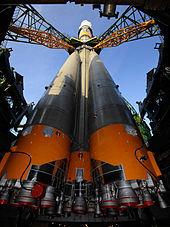[ID]
Roket peluncur Soyuz adalah sebuah sistem peluncuran yang didesain Biro Desain Korolev (Uni Soviet) dan digunakan untuk meluncurkanpesawat luar angkasa Soyuz, sebagai bagian dari program Soyuz. Meskipun begitu, roket Soyuz sebenarnya adalah peluncur kegunaan umum yang mempunyai fungsi-fungsi lain, termasuk peluncuran pesawat luar angkasa kargo dan peluncuran komersial yang dioperasikan TSeEsKAbe dan perusahaan Starsem.
Ada 11 peluncuran Soyuz pada tahun 2001 dan 9 pada 2002. Roket Soyuz diluncurkan dari Kosmodrom Baykonur di Kazakstan dan Kosmodrom Plesetsk di sebelah barat laut Rusia. Roket-roket Soyuz dibuat di Samara, Rusia.
Peluncur Soyuz diperkenalkan pada 1966, berdasarkan roket Vostok, yang sendiri dibuat berdasarkan 8K74 atau rudal balistik antarbenua R-7a. Soyuz awalnya adalah roket tiga-tahap dengan Blok I sebagai tahap teratas. Varian Molniya kemudian dibuat dengan menambahkan tahap keempat, memperbolehkannya mencapai orbit yang sangat oval. Selain itu ada pula varian yang lebih baru bernama Soyuz U.
[EN]
 |
| Soyuz Launch |
Soyuz (Russian: Союз, meaning "union", GRAU index 11A511) is a family of expendable launch systems developed by OKB-1, and manufactured by Progress State Research and Production Rocket Space Center in Samara, Russia. The Soyuz launch vehicle is the most frequently used launch vehicle in the world.
After the U.S. Space Shuttle program ended in 2011, Soyuz rockets became the only launch vehicle able to transport astronauts to the International Space Station.
The Soyuz vehicles are used as the launcher for the manned Soyuz spacecraft as part of the Soyuz program, as well as to launch unmanned Progress supply spacecraft to the International Space Station and for commercial launches marketed and operated byStarsem and Arianespace. All Soyuz rockets use RP-1 and liquid oxygen (LOX) propellant, with the exception of the Soyuz-U2, which used Syntin, a variant of RP-1, with LOX. In the United States, it has the Library of Congress designation A-2. The Soyuz family is a subset of the R-7 family
A space workhorse
The Soyuz launcher was introduced in 1966, deriving from the Vostok launcher, which in turn was based on the 8K74 or R-7aintercontinental ballistic missile. It was initially a three-stage rocket with a Block I upper stage. Later a Molniya variant was produced by adding a fourth stage, allowing it to reach the highly elliptical molniya orbit. A later variant was the Soyuz-U.
The production of Soyuz launchers reached a peak of 60 per year in the early 1980s. It has become the world's most used space launcher, flying over 1700 times, far more than any other rocket. Despite its age and perhaps thanks to its simplicity, this rocket family has been notable for its low cost and very high reliability, both of which appeal to commercial clients.
Soyuz / Fregat
In the early 1990s plans were made for a redesigned Soyuz with a Fregat upper stage. The Fregat engine was developed by NPO Lavochkin from the propulsion module of its Phobos interplanetary probes. Although endorsed by the Russian Space Agency and theRussian Ministry of Defence in 1993 and designated "Rus" as a Russification and modernisation of Soyuz, and later renamed Soyuz-2, a funding shortage prevented implementation of the plan. The creation of Starsem in July 1996 provided new funding for the creation of a less ambitious variant, the Soyuz-Fregat or Soyuz U/Fregat. This consisted of a slightly modified Soyuz U combined with the Fregat upper stage, with a capacity of up to 1,350 kg to geostationary transfer orbit. In April 1997, Starsem obtained a contract from the European Space Agency to launch two pairs of Cluster 2 plasma science satellites using the Soyuz-Fregat. Before the introduction of this new model, Starsem launched 24 satellites of the Globalstar constellation in 6 launches with a restartable Ikar upper stage, between September 22, 1999 and November 22, 1999. After successful test flights of Soyuz-Fregat on February 9, 2000 and March 20, 2000, the Cluster 2 satellites were launched on July 16, 2000 and August 9, 2000. Another Soyuz-Fregat launched the ESA's Mars Express probe from Baikonur in June 2003. Now the Soyuz-Fregat launcher is used by Starsem for commercial payloads.
ISS crew transport
Between February 1, 2003 and July 26, 2005 with the grounding of the U.S. Space Shuttle fleet, Soyuz was the only means of transportation to and from the International Space Station. This included the transfer of supplies, via Progress spacecraft, and crew changeovers. Since the retirement of the Space Shuttle fleet in 2011, the U.S. space program is without any means to take astronauts into orbit, and NASA is dependent on the Soyuz to send crew into space for the immediate future. NASA is scheduled to resume manned flights from the United States in late 2018 or 2019 through the Commercial Crew Development program.
Recent incidents
A long string of successful Soyuz launches was broken on October 15, 2002 when the unmanned Soyuz U launch of the Photon-M satellite from Plesetsk fell back near the launch pad and exploded 29 seconds after lift-off. One person from the ground crew was killed and eight injured. Another failure occurred on June 21, 2005, during a Molniya military communications satellite launch from the Plesetsk launch site, which used a four-stage version of the rocket called Molniya-M. The flight ended six minutes after the launch because of a failure of the third stage engine or an unfulfilled order to separate the second and third stages. The rocket's second and third stages, which are identical to the Soyuz, and its payload (a Molniya-3K satellite) crashed in the Uvatski region of Tyumen (Siberia). On August 24, 2011, an unmanned Soyuz-U carrying cargo to the International Space Station crashed, failing to reach orbit. On December 23, 2011 a Soyuz-2.1b launching a Meridian-5 military communications satellite failed in the 7th minute of launch because of an anomaly in the third stage.
Soyuz-2 and Guiana spaceport
The venerable Soyuz launcher is gradually being replaced by a new version, now named Soyuz/ST (or Soyuz-2), which has a new digital guidance system and a highly modified third stage with a new engine. The first development version of Soyuz 2 called Soyuz-2-1a, which is already equipped with the digital guidance system, but is still propelled by an old third stage engine, started on November 4, 2004 from Plesetsk on a suborbital test flight, followed by an orbital flight on October 23, 2006 from Baikonur. The fully modified launcher (version Soyuz-2-1b) flew first on December 27, 2006 with the CoRoT satellite from the Baikonur Cosmodrome.
On 19 January 2005, the European Space Agency and the Russian Federal Space Agency agreed to launch Soyuz/ST rockets from theGuiana Space Centre. The equatorial launch site allows the Soyuz to deliver 2.7 to 4.9 tonnes into sun-synchronous orbit, depending on the third-stage engine used. Construction of a new pad started in 2005 and was completed in April 2011. The pad used vertical loading common at Guiana, unlike the horizontal loading used at the Baikonur Cosmodrome. A simulated launch was conducted in early May 2011. The first operational launch happened on 21 October 2011, bearing the first two satellites in Galileo global positioning system.
The Soyuz-U and Soyuz-FG rockets, which are still in service, are gradually being replaced by Soyuz-2 from 2014 onwards and should be retired in 2016..





